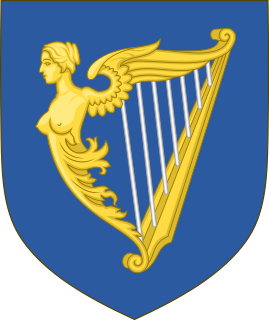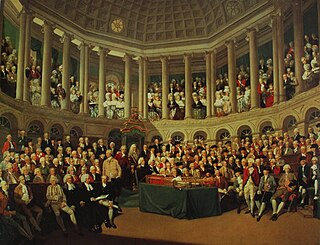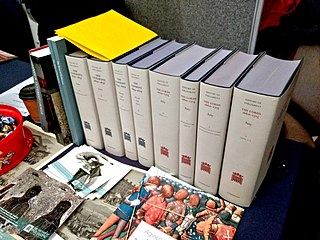Related Research Articles

The House of Commons is the lower house and de facto primary chamber of the Parliament of the United Kingdom. Like the upper house, the House of Lords, it meets in the Palace of Westminster.

The Parliament of the United Kingdom is the supreme legislative body of the United Kingdom, the Crown dependencies and the British overseas territories. It alone possesses legislative supremacy and thereby ultimate power over all other political bodies in the UK and the overseas territories. Parliament is bicameral but has three parts, consisting of the sovereign (Crown-in-Parliament), the House of Lords, and the House of Commons. Parliament is also tasked with enforcing the laws that it passes. The political party or party coalition that controls the majority of seats in the lower house (commons) chooses the national executive for the country, the Prime Minister of the United Kingdom. The Prime Minister and their cabinet wield the executive powers for the entire country but must possess the confidence of Parliament otherwise, lose their office. Because of this it is not unusual for Parliament to hold elections more frequently than the required five years. Both houses meet in the Palace of Westminster in the City of Westminster, one of the inner boroughs of the capital city, London.

The United Kingdom is a unitary state with devolution that is governed within the framework of a parliamentary democracy under a constitutional monarchy in which the monarch, currently Queen Elizabeth II, is the head of state while the Prime Minister of the United Kingdom, currently Boris Johnson, is the head of government. Executive power is exercised by the British government, on behalf of and by the consent of the monarch, and the devolved governments of Scotland, Wales and Northern Ireland. Legislative power is vested in the two chambers of the Parliament of the United Kingdom, the House of Commons and the House of Lords, as well as in the Scottish and Welsh parliaments and the Northern Ireland Assembly. The judiciary is independent of the executive and the legislature. The highest court is the Supreme Court of the United Kingdom.
A member of parliament (MP) is the representative of the people who live in their constituency. In many countries with bicameral parliaments, this category includes specifically members of the lower house, as upper houses often have a different title. Member of Congress or Deputy is an equivalent term in other jurisdictions. Another term is Parliamentarian.

The Irish House of Commons was the lower house of the Parliament of Ireland that existed from 1297 until 1800. The upper house was the House of Lords. The membership of the House of Commons was directly elected, but on a highly restrictive franchise, similar to the Unreformed House of Commons in contemporary England and Great Britain. In counties, forty-shilling freeholders were enfranchised whilst in most boroughs it was either only the members of self-electing corporations or a highly-restricted body of freemen that were able to vote for the borough's representatives. Most notably, Catholics were disqualified from sitting in the Irish parliament from 1691, even though they comprised the vast majority of the Irish population. From 1728 until 1793 they were also disfranchised. Most of the population of all religions had no vote. The vast majority of parliamentary boroughs were pocket boroughs, the private property of an aristocratic patron. When these boroughs were disfranchised under the Act of Union, the patron was awarded £15,000 compensation for each.

The House of Commons is the name for the elected lower house of the bicameral parliaments of the United Kingdom and Canada. In the UK and Canada, the Commons holds much more legislative power than the nominally upper house of parliament. The leader of the majority party in the House of Commons by convention becomes the prime minister. Other parliaments have also had a lower house called a "House of Commons".

The House of Commons of Northern Ireland was the lower house of the Parliament of Northern Ireland created under the Government of Ireland Act 1920. The upper house in the bicameral parliament was called the Senate. It was abolished with the passing of the Northern Ireland Constitution Act 1973.

The Parliament of Ireland was the legislature of the Lordship of Ireland, and later the Kingdom of Ireland, from 1297 until 1800. It was modelled on the Parliament of England and from 1537 comprised two chambers: the House of Commons and the House of Lords. The Lords were members of the Irish peerage and bishops. The Commons was directly elected, albeit on a very restricted franchise. Parliaments met at various places in Leinster and Munster, but latterly always in Dublin: in Christchurch Cathedral, Dublin Castle, Chichester House (1661–1727), the Blue Coat School (1729–31), and finally a purpose-built Parliament House on College Green.
In Ireland, direct elections by universal suffrage are used for the President, the ceremonial head of state; for Dáil Éireann, the house of representatives of the Oireachtas or parliament; for the European Parliament; and for local government. All elections use the proportional representation by means of the single transferable vote (PR-STV) in constituencies returning three or more members, except that the presidential election and by-elections use the single-winner analogue of STV, elsewhere called instant-runoff voting or the alternative vote. Members of Seanad Éireann, the second house of the Oireachtas, are partly nominated, partly indirectly elected, and partly elected by graduates of particular universities.

In the United Kingdom (UK), each of the electoral areas or divisions called constituencies elects one member to the House of Commons.
Mitchell, or St Michael was a rotten borough consisting of the town of Mitchell, Cornwall. From the first Parliament of Edward VI, in 1547, it elected two members to the Unreformed House of Commons.
Londonderry City was a parliamentary constituency in Ireland. It returned one Member of Parliament (MP) to the House of Commons of the Parliament of the United Kingdom, elected by the first past the post voting system.

In the United Kingdom, a Member of Parliament (MP) is an individual elected to serve in the House of Commons of the Parliament of the United Kingdom.
University of Dublin is a university constituency in Ireland, which currently elects three senators to Seanad Éireann. Its electorate comprises the undergraduate scholars and graduates of the University of Dublin, whose sole constituent college is Trinity College Dublin, so it is often also referred to as the Trinity College constituency. Between 1613 and 1937 it elected MPs or TDs to a series of representative legislative bodies.
Carrickfergus was a constituency represented in the Irish House of Commons from 1326 to 1800.
St Canice, also called Irishtown, was a constituency represented in the Irish House of Commons from the 1661 until 1800. Irishtown was a borough within the parish of St Canice in the county of the city of Kilkenny. The borough was separate from the city itself, which was represented by Kilkenny City constituency.

The History of Parliament is a project to write a complete history of the United Kingdom Parliament and its predecessors, the Parliament of Great Britain and the Parliament of England. The history will principally consist of a prosopography, in which the history of an institution is told through the individual biographies of its members. After various amateur efforts the project was formally launched in 1940 and since 1951 has been funded by the Treasury. As of 2019, the volumes covering the House of Commons for the periods 1386–1421, 1509–1629, and 1660–1832 have been completed and published ; and the first five volumes covering the House of Lords from 1660-1715 have been published, with further work on the Commons and the Lords ongoing. In 2011 the completed sections were republished on the internet.
References
- "Part II; Parliaments of Ireland". Return of the name of every member of the lower house of parliament of England, Scotland, and Ireland, with name of constituency represented, and date of return, from 1213 to 1874. Command papers. C.69-I. HMSO. 1878. pp. 603–691.
| | This Irish history article is a stub. You can help Wikipedia by expanding it. |